Before Shang-Chi: Asian Heroes from the Golden Age of Comic Books
Comic books have always had Asian characters, but few are memorable, and most that are memorable are memorable for the wrong reasons. I’ll focus on the heroes who are most important and a few who deserve more attention.
- Wing, the Crimson Avenger’s assistant
The history of Asian comic book heroes begins with a radio show, The Green Hornet. Its title character was a white newspaper publisher who put on a mask to fight crime with his Asian valet and chauffeur, Kato. Since the first principle of commercial entertainment is to swipe whatever sells, Detective Comics in 1938 introduced a new series, the Crimson Avenger. Its title character was a white newspaper publisher who put on a mask to fight crime with his Asian valet and chauffeur, Ka — , I mean, Wing.
Wing and the Avenger being blatant Kato and the Hornet knock-offs doesn’t affect Wing’s status as the first Asian comic book hero. Some say Wing and the Crimson Avenger were DC’s first superheroes because they debuted before Superman, but like Kato and the Green Hornet, Wing and the Avenger were mystery men, predecessors to the superhero who wore masks and street clothes instead of special costumes and fought crime with human skills instead of super powers.
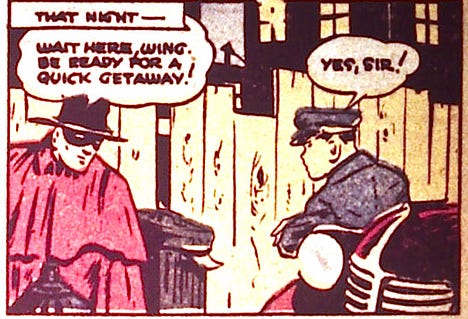
Wing was originally a competent supporting character treated with a reasonable amount of respect by his writers. But when Wing and the Crimson Avenger adopted brightly colored tights to capitalize on the superhero craze, Wing became a scrawny, buck-toothed speaker of pidgen English in a funny-looking outfit whose service to the hero did not change the fact that the white member of the team was the one to admire and the Asian was the one to laugh at.
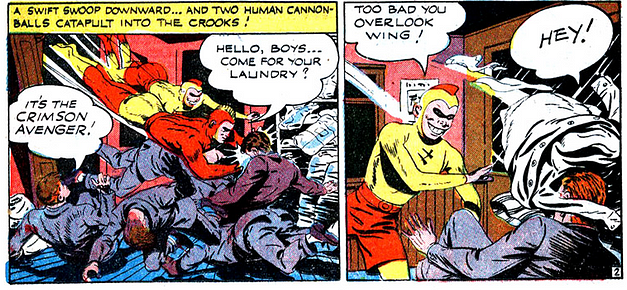
To their credit, the Green Hornet’s writers didn’t turn Kato into a clown when the Green Hornet comic book started in 1940.
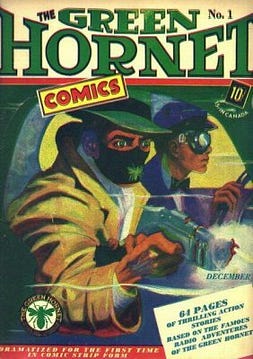
- Fu Chang, International Detective and Dr. Fung, Master Sleuth of the Orient
1939 saw an advance for Asian heroes: two starred in their own series.
Fu Chang, International Detective, was a magician who lived in San Franciso’s Chinatown. He’s an interesting example of the inconsistencies in the depiction of Asians in old comics: In his first story, he and his love interest, Tay Ming, had pink skin while his opponent was bright yellow, the cartoon coding for Asian.
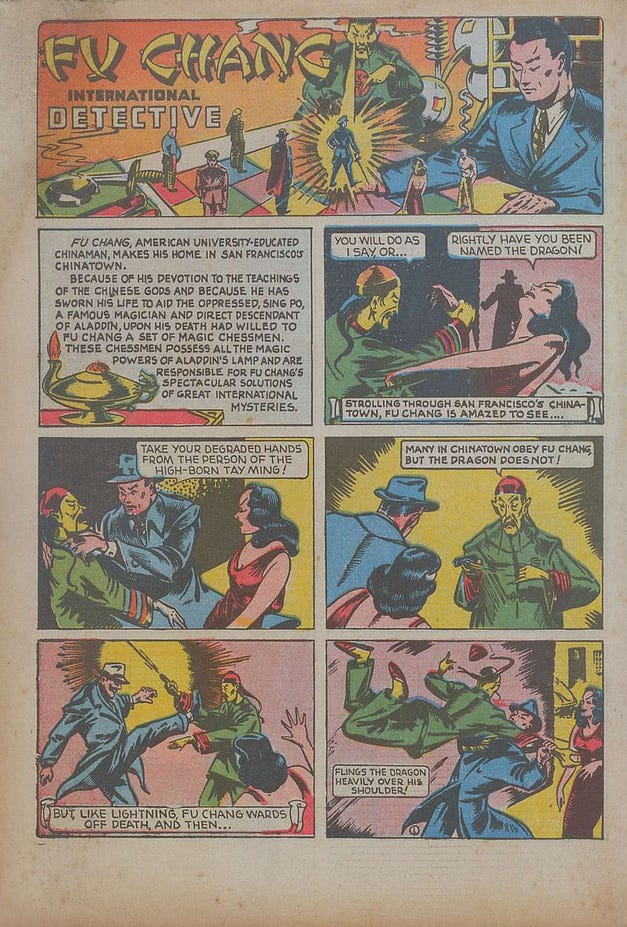
In later stories, Fu Chang sometimes had orange skin while Tay Ming stayed pink and most Asian characters were yellow.
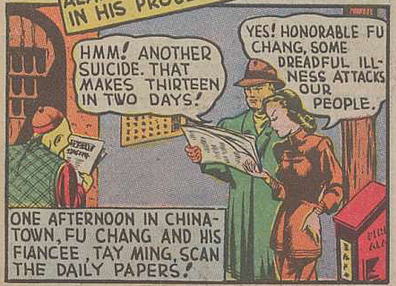
Despite the skin coding, Fu Chang was treated as well as any white hero of the time.
Dr. Fung, Master Sleuth of the Orient, was inspired by fictional Asian detectives like Charlie Chan and Mr. Moto, but his creator added an interesting element: Dr. Fung had a white assistant who was clearly his subordinate, essentially a Dr. Watson to Dr. Fung’s Sherlock Holmes.
In the early stories, Dr. Fung is either pink or orange.
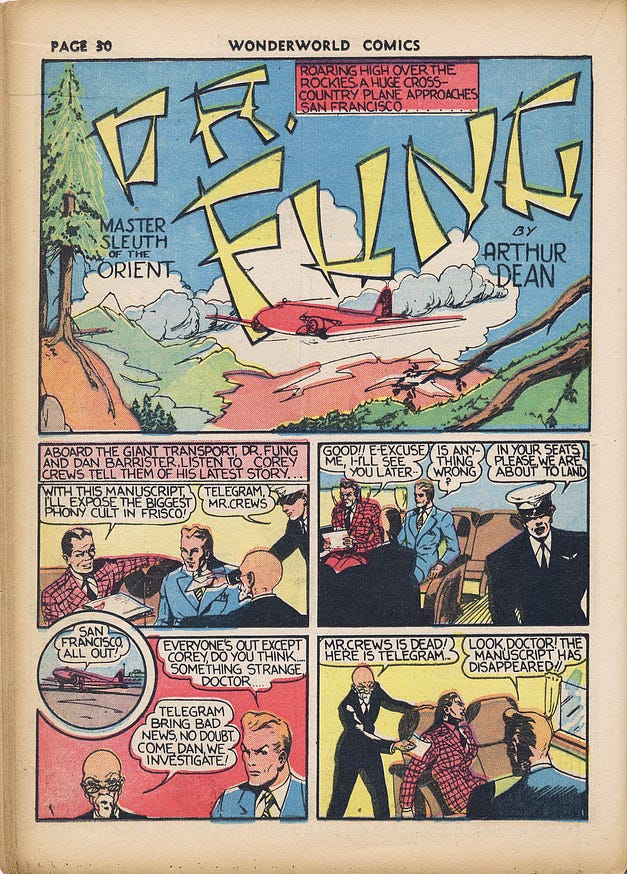
In later stories, he is colored yellow, yet he stays the hero of the story.
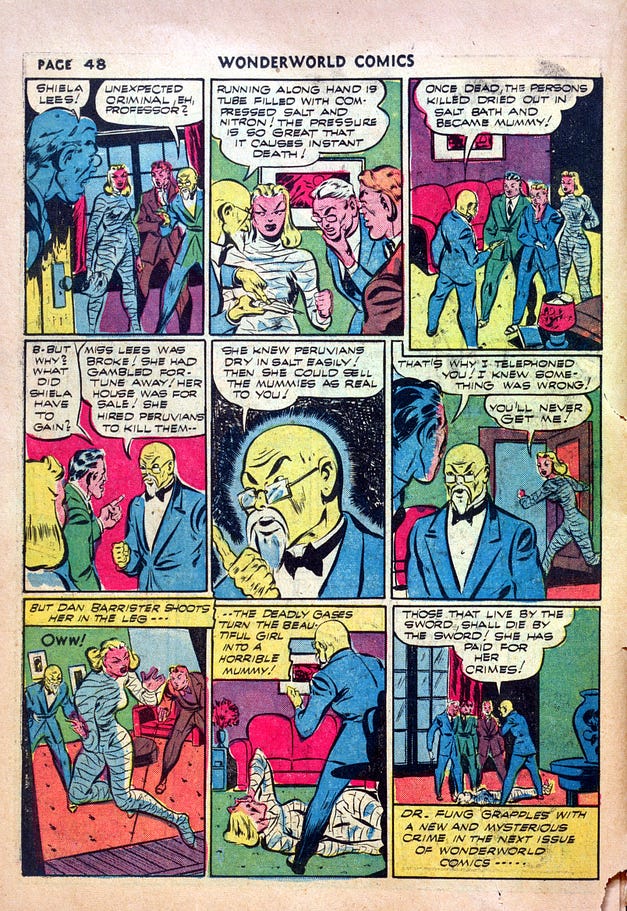
- The Tulpa of Tsang and Low of the Flying Trio
In 1940, a minor yet interesting Asian character appeared in a one-shot book from a small publisher. Tibet was a popular place for white heroes to visit and acquire power—examples include Amazing Man, the Green Lama, Mr. Mystic, the Flame, and the first Wonder Man—but the Tulpa of Tsang was a rare example of a native Tibetan hero.
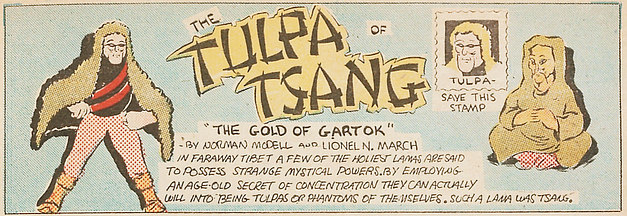
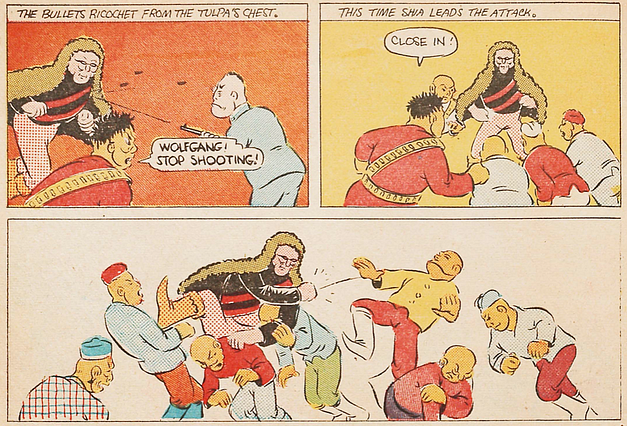
Another Asian hero appeared that year: Low was one of the Flying Trio, a strip that ran in the first five issues of Crash Comics. Though he’s listed third, he gets to show off on the first page of the first story, before either of his white pals.
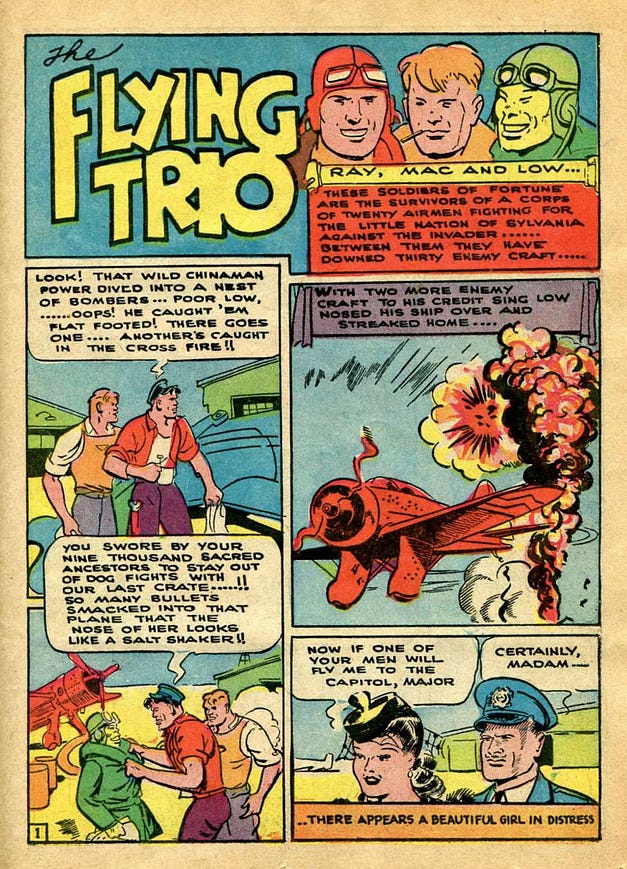
Low is not the star of the strip, but he’s as capable as his white teammates.
- Chop-Chop of the Blackhawks
In 1941, an extraordinarily popular comic book began with an admirable intention: the Blackhawks were an international team. The Polish leader recruited one pilot from America and the rest from countries that were occupied by the Nazis. You might think there would also have been a Chinese pilot since China was occupied by the Japanese.
But one member of the Blackhawks was not like the others:
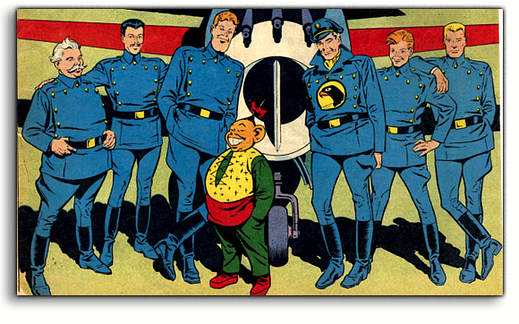
Chop-Chop joined the Blackhawk cast in the third episode as the team’s cook and mascot. He would remain a racist cliché until the late 1950s, when his writers slowly began humanizing him, a surprisingly slow process: he did not become a full member of the Blackhawks until 1964.
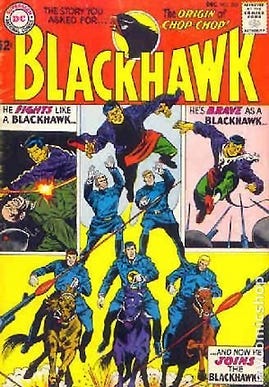
- Mei-Ling of the Girl Commandos and Stuff, the Vigilante’s sidekick
In 1942, another international team of heroes appeared. It might have been inspired by the Blackhawks, but the writer didn’t think she needed an Asian clown. Though the British Pat Parker was the leader of the Girl Commandos (who were girls in the slang sense only), Mei-Ling was clearly as good as her British, American, and Russian teammates.
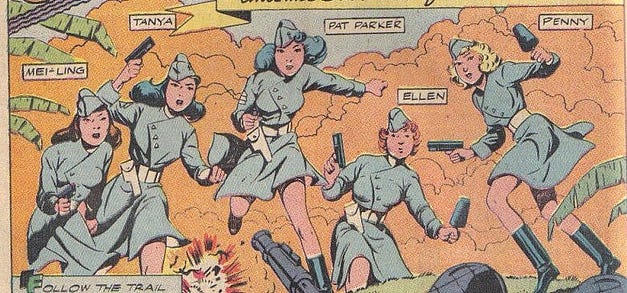
As often happened, Mei-Ling’s skin color varied from issue to issue, but she was always drawn and written as a fully human and capable member of the team.
And a DC Comics hero, the Vigilante, acquired an Asian partner, Stuff the Chinatown Kid. His dialogue made it clear he was a thoroughly American boy.
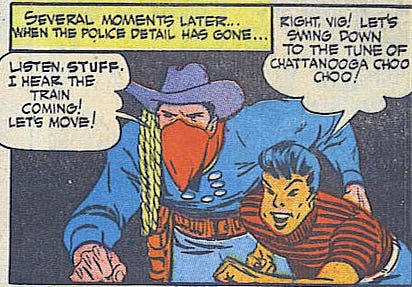
- Junior Ranger Chin Lee and the Boy Patriot of China
In 1943, the Junior Rangers began as a group of three white boys, but their second story introduced their fourth member, Chin Lee. One of the boys responded to him with wary prejudice.
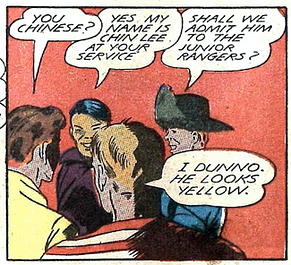
But Chin Lee proved himself by the end of the story. He did not appear on the cover of the book for five issues. When he did, a point was clearly made: The Asian Junior Ranger was also “for the American boy”.
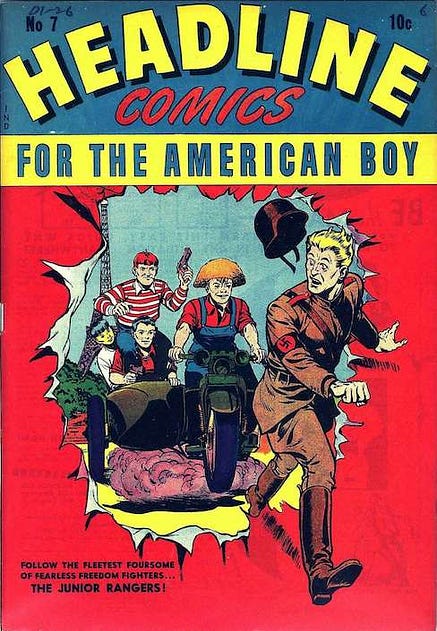
1943 saw another Chinese character become the title hero of a strip in the Blue Beetle comic: the Boy Patriot of China fought the Japanese for three issues.
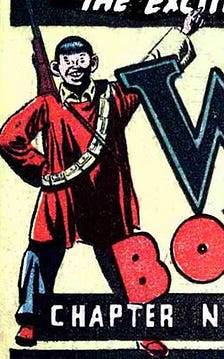
- The Green Turtle and Burma Boy, and Tiger Girl and Abdola
In 1944, the Green Turtle appeared in five issues of Blazing Comics. He was an extreme example of the mystery man: the reader never learned who he had been or what he looked like under his mask or even, in most panels, what he looked like with his mask on—the artist, Chu Hing, usually drew him from behind or with something obscuring the face. I agree with the popular theory: Chu Hing wanted the Green Turtle to be Chinese, but the publisher did not, so his compromise was to never show the Turtle’s features clearly.
But Burma Boy, an orphaned beggar who became the Green Turtle’s sidekick, was unambiguously Asian.
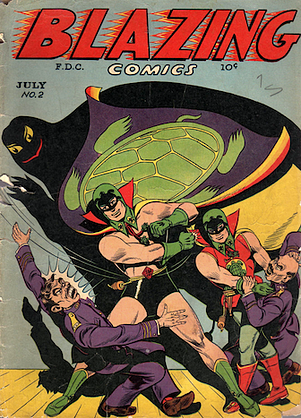
Two more Asian heroes appeared that year in Fight Comics. Tiger Girl looked like a generic example of the jungle queen craze, but she differed from her sisters in two important ways. In a time when people from India could not become US citizens because the Supreme Court in 1923 had declared them Caucasian but not white, Tiger Girl was the daughter of an Indian prince and an Irish woman.
Now, you may think the fact she looked like her red-haired mother made her less of an Asian hero, but then consider the second thing that set her apart. In a time when many Americans were obsessed with racial segregation, her human companion was Abdola, a handsome young Sikh.
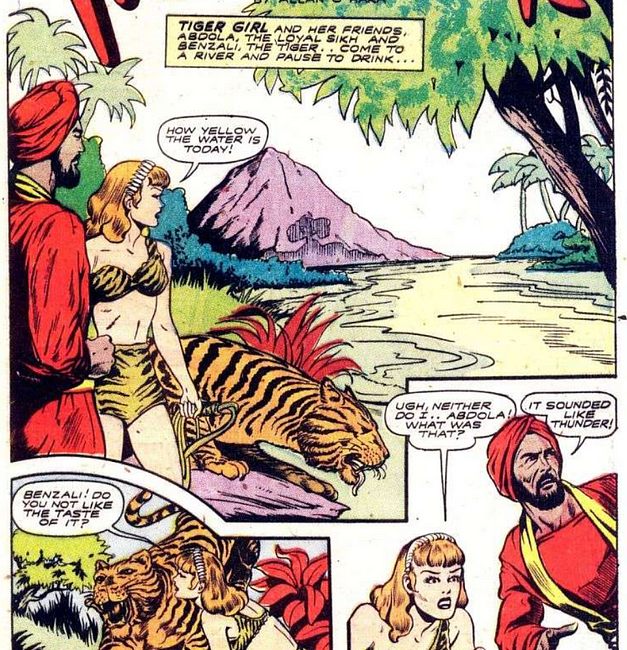
Tiger Girl became a blonde later in the series, which may have made her seem even more white to readers who didn’t know about her Indian father, but Abdola continued to be her human companion.
• Alani the South Seas Girl
In 1946, another jungle queen appeared in Seven Seas Comics.
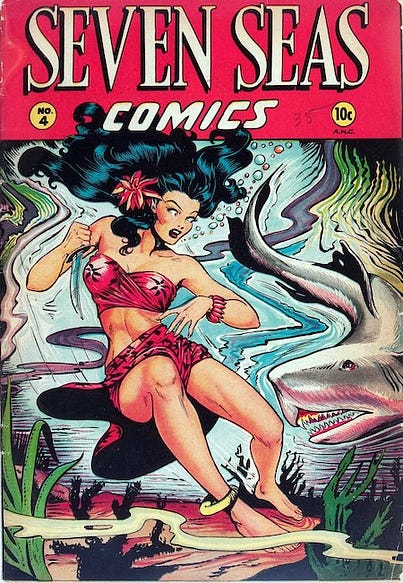
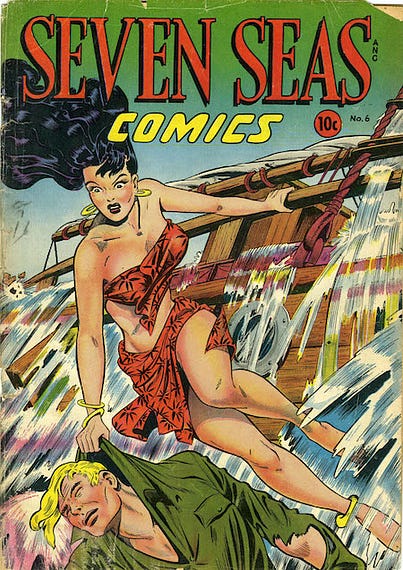
Though jungle queens had been popular in comic books since Sheena, Queen of the Jungle, appeared in 1938, Alani the South Sea Girl may have been the only one who wasn’t at least partly white. She continues to be popular with comic book fans because her stories were drawn by Matt Baker, a black artist known for drawing attractive women.
- Moon Girl, Prince Mengu, and Starlet
The last major Asian heroes of the comic book’s Golden Age appeared as the Golden Age was ending. In 1947, Moon Girl had her own title for nine issues. (Though, as was surprisingly common, that title changed several times, going from Moon Girl and the Prince to just Moon Girl to Moon Girl Fights Crime to A Moon, a Girl… Romance.)
Moon Girl was a warrior princess from Samarkand who came to the United States. While clearly intended to appeal to Wonder Woman fans, she managed to be more than a clone.
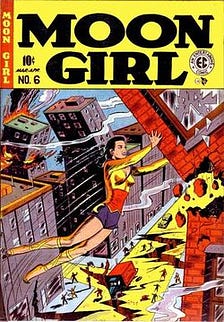
Her first sidekick was Prince Mengu, who also came from Samarkand, and who she had defeated in battle.
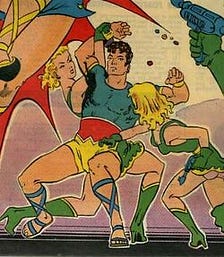
She soon acquired a more traditional superhero sidekick, a younger character of her sex. Star, aka Starlet, was a biracial girl born in the US whose mother was from Samarkand.
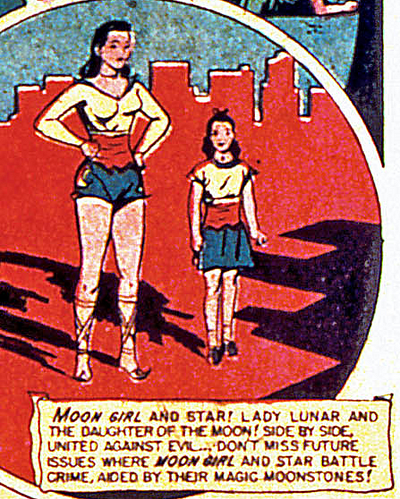
- After the Golden Age
There would be a few new Asian comic book heroes in the next two decades — my favorite is Jimmy Woo, an FBI agent who appeared in the four-issue run of a comic named for its clichéd Asian villain, the Yellow Claw.
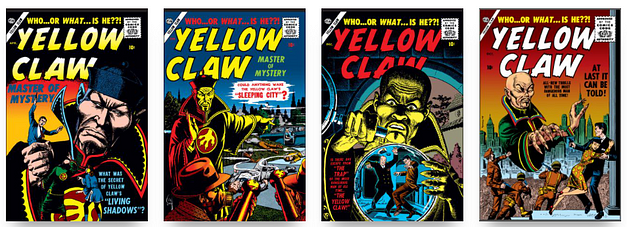
But no Asian hero would get his own series until Shang-Chi arrived in 1973.
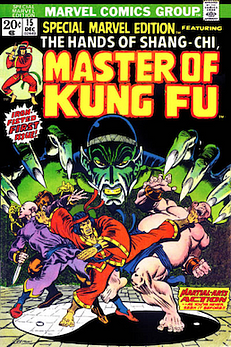
Comments
Post a Comment